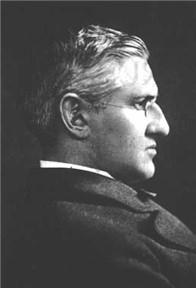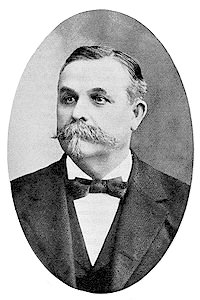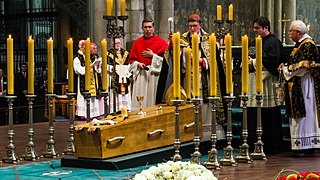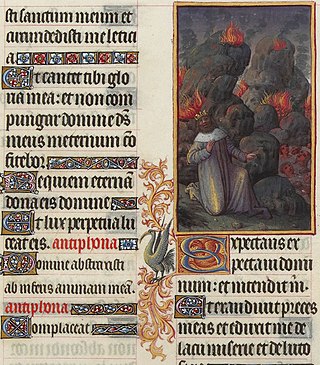
The Magnificat is a canticle, also known as the Song of Mary, the Canticle of Mary and, in the Byzantine tradition, the Ode of the Theotokos. It is traditionally incorporated into the liturgical services of the Catholic Church, the Eastern Orthodox Church, Lutheran Churches and the Anglican Communion. Its name comes from the incipit of the Latin version of the text.

The American religious foundation and philanthropy that informally became known as the American Colony of Jerusalem, was established in the Ottoman Empire in 1881 as a "Christian utopian society" led by American religious leader Horatio Gates Spafford and his Norwegian wife Anne Tobine Larsen Øglende. Largely concerned with providing social services, education, meeting spaces, and medical care, it became known for producing and publishing an important documentation, photographic series of the area of Jerusalem starting in the early 1900s. The community lasted until the 1950s.

Gerhard Tersteegen, was a German Reformed religious writer and hymnist.

Philip Paul Bliss was an American composer, conductor, writer of hymns and a bass-baritone Gospel singer. He wrote many well-known hymns, including "Hold the Fort" (1870), "Almost Persuaded" (1871); "Hallelujah, What a Saviour!" (1875); "Let the Lower Lights Be Burning"; "Wonderful Words of Life" (1875); and the tune for Horatio Spafford's "It Is Well with My Soul" (1876). Bliss was a recognized friend of D. L. Moody, the famous Chicago preacher. Bliss died in the Ashtabula River Railroad Disaster on his way to one of Moody's meetings. An outspoken Abolitionist, he served as a Lieutenant during the American Civil War.

Horatio Gates Spafford was an American lawyer and Presbyterian church elder. He is best known for penning the Christian hymn It Is Well With My Soul following the Great Chicago Fire and the deaths of his four daughters on a transatlantic voyage aboard the S.S. Ville du Havre.
"How Great Thou Art" is a Christian hymn based on an original Swedish hymn entitled "O Store Gud" written in 1885 by Carl Boberg (1859–1940). The English version of the hymn and its title are a loose translation by the English missionary Stuart K. Hine from 1949. The hymn was popularised by George Beverly Shea and Cliff Barrows during Billy Graham's crusades. It was voted the British public's favourite hymn by BBC's Songs of Praise. "How Great Thou Art" was ranked second on a list of the favourite hymns of all time in a survey by Christianity Today magazine in 2001 and in a nationwide poll by Songs Of Praise in 2019.

Psalm 69 is the 69th psalm of the Book of Psalms, beginning in English in the King James Version: "Save me, O God; for the waters are come in unto my soul". It is subtitled: "To the chief musician, upon Shoshannim, a Psalm of David". The Book of Psalms is part of the third section of the Hebrew Bible, and a book of the Christian Old Testament. In the slightly different numbering system used in the Greek Septuagint version of the Bible and in the Latin Vulgate, this psalm is Psalm 68. In Latin, it is known as "Salvum me fac Deus". It has 36 verses.

James McGranahan was a nineteenth-century American musician and composer, most known for his various hymns. He was born 4 July 1840, in West Fallowfield or Adamsville, Pennsylvania, and died 9 July 1907 at his home in Kinsman, Ohio.
Theos Kyrios is a psalm response chanted near the beginning of the Matins service in the Rite of Constantinople, observed by the Eastern Orthodox and Byzantine Catholic churches. It is based principally on Psalm 117, the refrain composed of verses v. 27a and 26a.

Ville du Havre was a French iron steamship that operated round trips between the northern coast of France and New York City. Launched in November 1865 under her original name of Napoléon III, she was converted from a paddle steamer to single propeller propulsion in 1871 and, in recognition of the recent defeat and removal from power of her imperial namesake, the Emperor Napoleon III, was renamed Ville du Havre. It was named after Le Havre, a major port city in the Normandy region of northern France.

Anna Spafford, born Anne Tobine Larsen Øglende in Stavanger, Norway, was a Norwegian-American woman who settled in Jerusalem, where she and her husband Horatio Spafford were central in establishing the American Colony there in 1881.

Absolution of the dead is a prayer for or a declaration of absolution of a dead person's sins that takes place at the person's religious funeral.

Psalm 40 is the 40th psalm of the Book of Psalms, beginning in English in the King James Version: "I waited patiently for the LORD". The Book of Psalms is part of the third section of the Hebrew Bible, and a book of the Christian Old Testament. In the slightly different numbering system used in the Greek Septuagint and Latin Vulgate translations of the Bible, this psalm is Psalm 39. In Latin, it is known by the incipit, "Expectans expectavi Dominum". It is described by the Jerusalem Bible as a "song of praise and prayer for help".

Psalm 132 is the 132nd psalm of the Book of Psalms, beginning in English in the King James Version: "LORD, remember David, and all his afflictions". In the slightly different numbering system used in the Greek Septuagint version of the bible and in the Latin Vulgate, this psalm is Psalm 130. In Latin, it is known as "Memento Domine David".

Psalm 50, a Psalm of Asaph, is the 50th psalm from the Book of Psalms in the Bible, beginning in English in the King James Version: "The mighty God, even the LORD, hath spoken, and called the earth from the rising of the sun unto the going down thereof." In the slightly different numbering system used in the Greek Septuagint and Latin Vulgate translations of the Bible, this psalm is Psalm 49. The opening words in Latin are Deus deorum, Dominus, locutus est / et vocavit terram a solis ortu usque ad occasum. The psalm is a prophetic imagining of God's judgment on the Israelites.

Psalm 66 is the 66th psalm of the Book of Psalms, beginning in English in the King James Version: "Make a joyful noise unto God, all ye lands". In the slightly different numbering system of the Greek Septuagint version of the Bible and the Latin Vulgate, this psalm is Psalm 65. In Latin, it is known as "Iubilate Deo omnis terra". It is a psalm of thanksgiving probably intended for use at the Passover. The psalm is divided into two parts: in verses 1-12 the community praises God and invites the whole world to join in praise; in verses 13–20, "an individual from the rescued community fulfils a vow to offer a sacrifice of thanksgiving".

Psalm 102 is the 102nd psalm of the Book of Psalms, beginning in English in the King James Version: "Hear my prayer, O LORD, and let my cry come unto thee." In Latin, it is known as "Domine exaudi orationem meam".

Psalm 116 is the 116th psalm of the Book of Psalms, beginning in English in the King James Version: "I love the LORD, because he hath heard my voice and my supplications". It is part of the Egyptian Hallel sequence in the Book of Psalms.
The 66 Chorale improvisations for organ, Op. 65, were composed by Sigfrid Karg-Elert between 1906 and 1908, and first published in six volumes in 1909. The composition was dedicated to "the great organist Alexandre Guilmant".



















